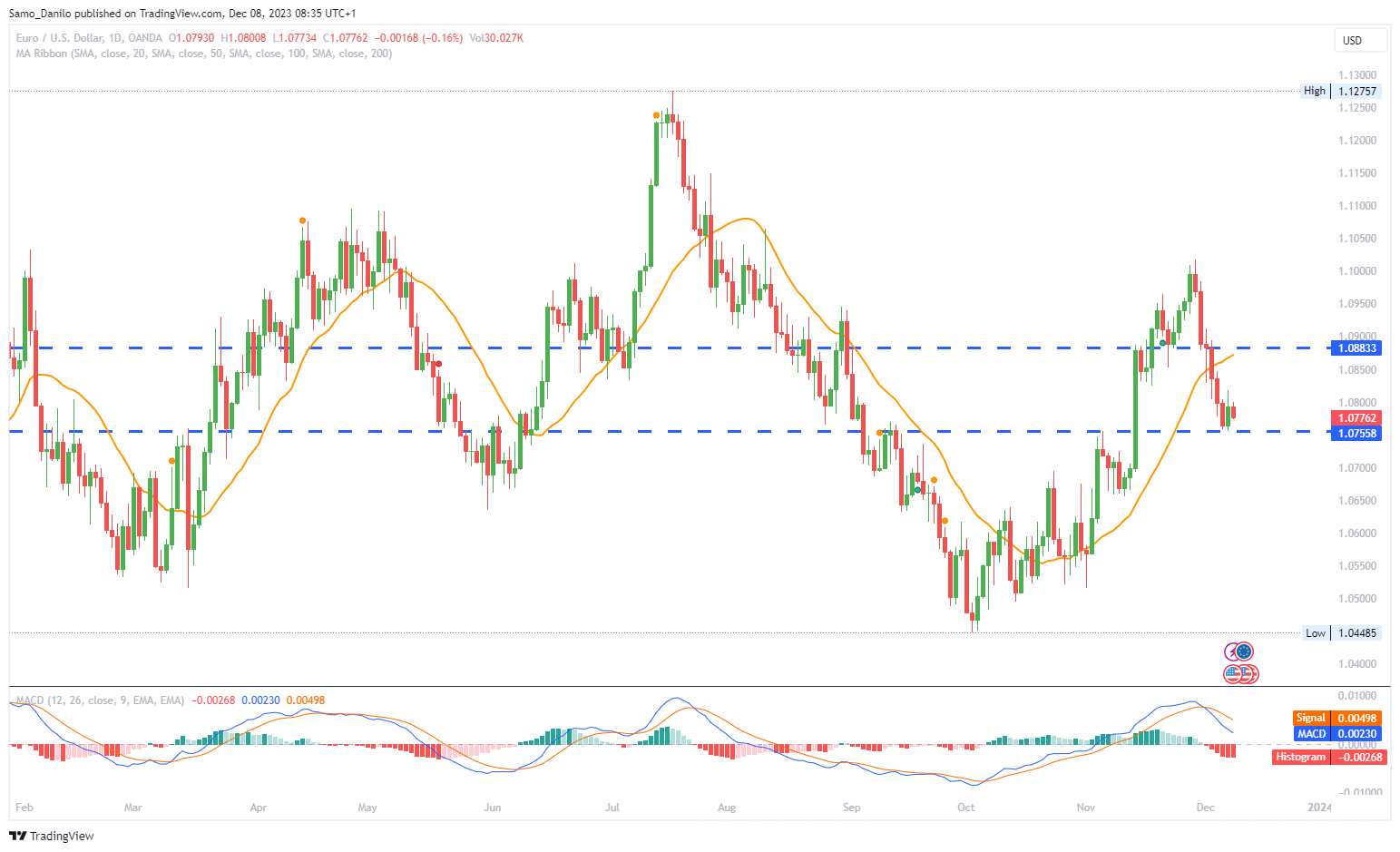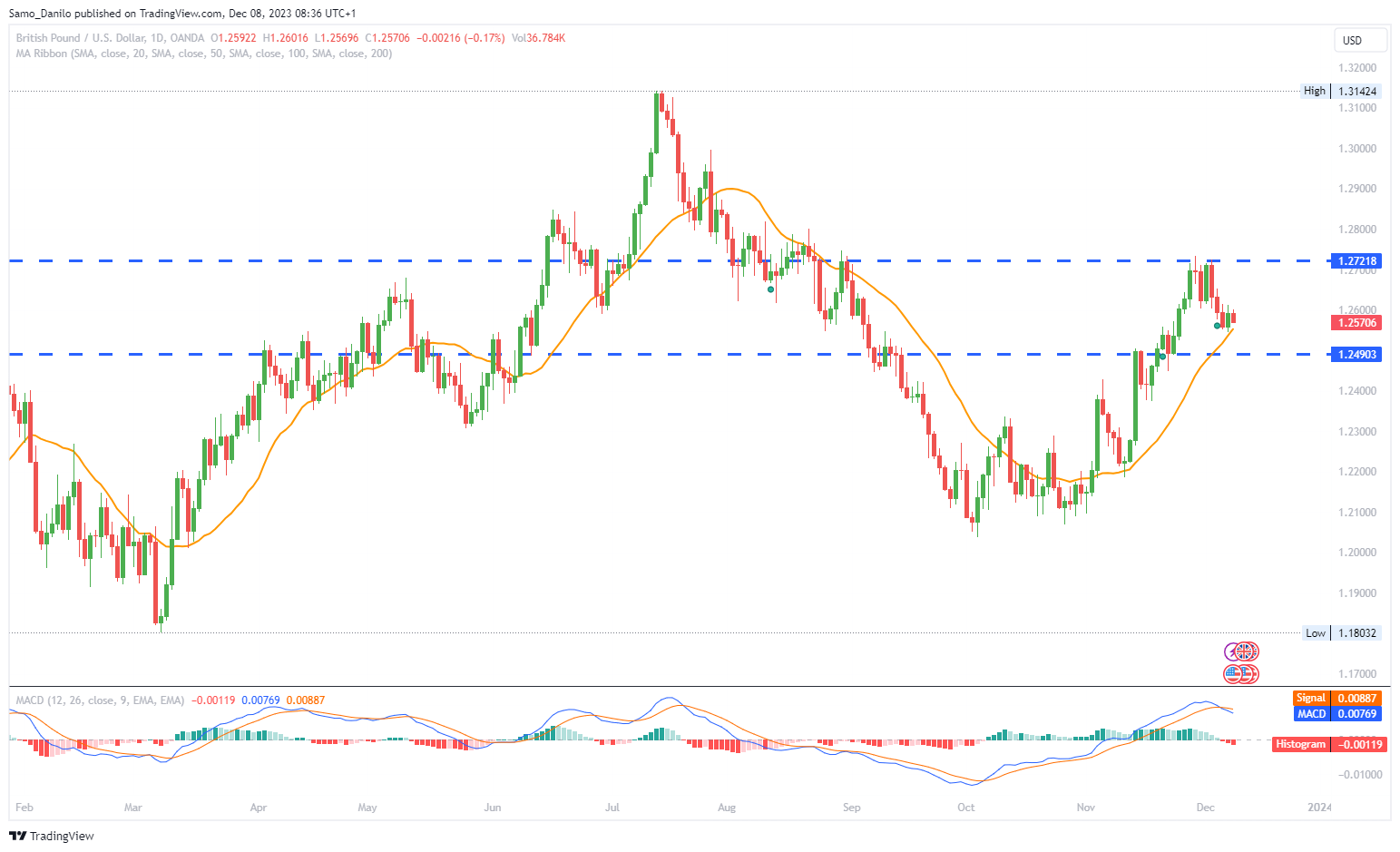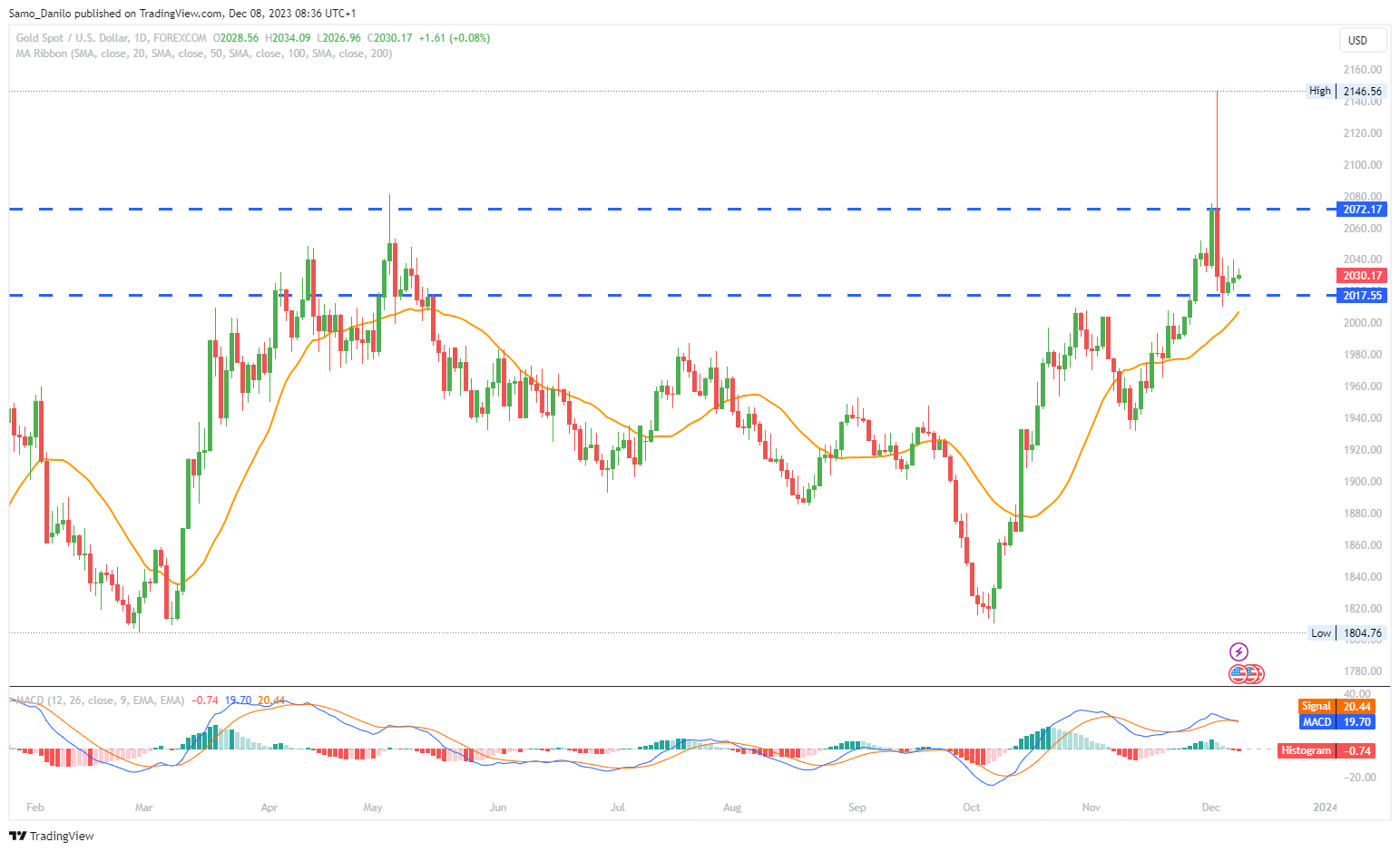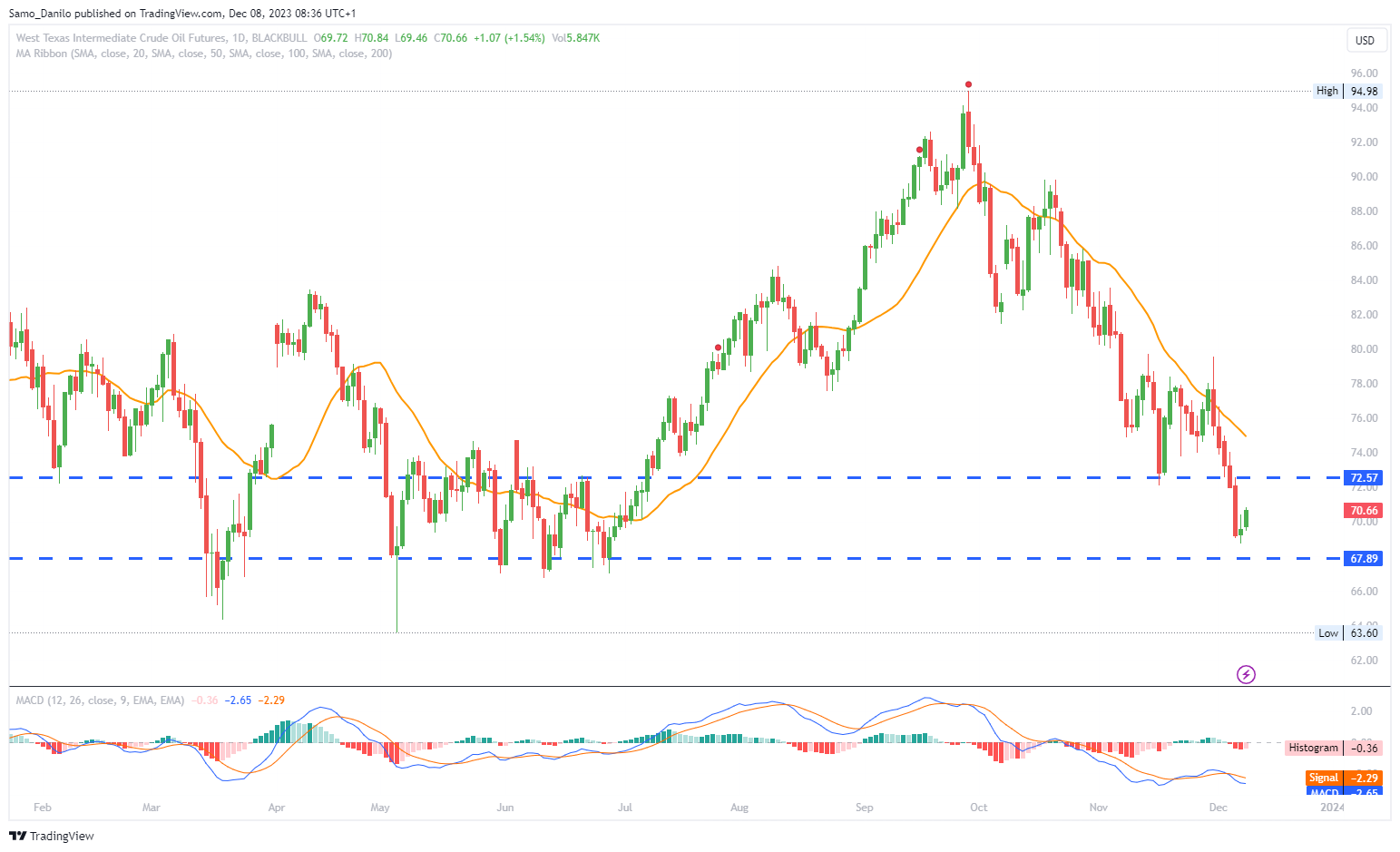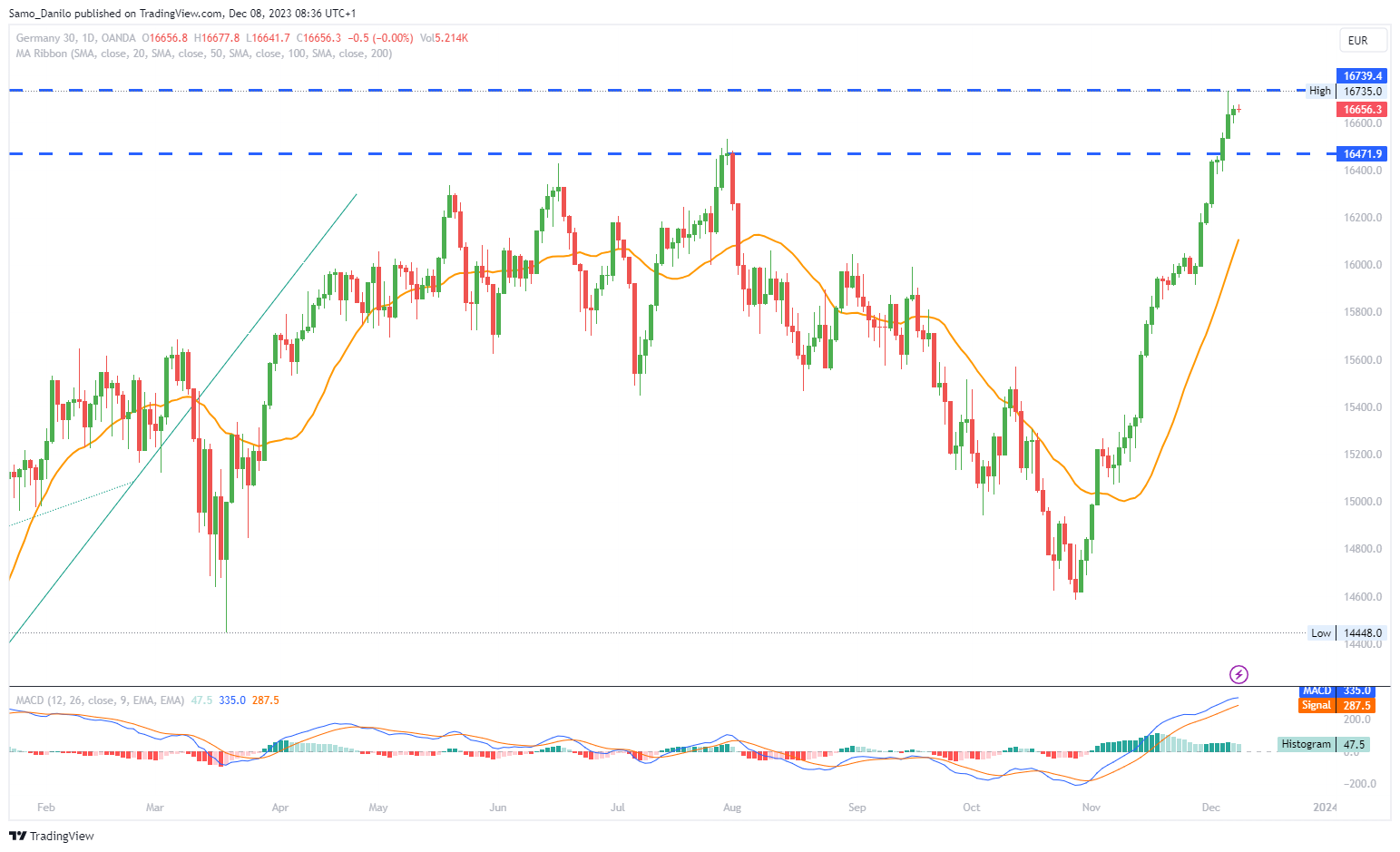EURUSD
- The EUR/USD rebounded from three-week lows, reaching a peak at 1.0817, but is currently hovering around the 1.079 area, reflecting a degree of volatility.
- The Eurozone's economic outlook remains bleak, contributing to market expectations that the European Central Bank (ECB) might take preemptive measures, possibly cutting rates, ahead of the Federal Reserve (Fed).
- The Eurozone's economy unexpectedly slowed in Q3 2023, with Gross Domestic Product (GDP) registering 0% YoY, worse than the previous 0.1%. The quarterly growth figure contracted by 0.1%, aligning with market forecasts.
- ECB board member Isabel Schnabel emphasized last month that rate hikes must remain an option if inflation doesn't return quickly to the 2% target, providing insights into the ECB's cautious approach.
- Aggressive market pricing suggests that the ECB could cut interest rates earlier than initially anticipated, with the first rate cut potentially happening as early as March 2024.
Closing statement: Aggressive market pricing suggests that the ECB could cut interest rates earlier than initially anticipated, with the first rate cut potentially happening as early as March 2024.
GBPUSD
- GBP/USD experienced a rebound toward the 1.2600 level after touching a two-week low below 1.2550 earlier in the day, signaling a reversal in intraday sentiment.
- The Bank of England (BoE) is expected to maintain the interest rate at 5.25% in the upcoming week and potentially throughout the second quarter of 2024, providing a stabilizing factor for the Pound.
- BoE Governor Bailey indicated that interest rates need to stay high for an extended period, emphasizing that discussions about interest rate cuts are not currently on the table, providing a hawkish outlook.
- The US Initial Jobless Claims rose to 220K in the week ending December 2, a slight increase from the previous week's 218K, indicating some volatility in the US labor market.
- Traders are eyeing the US employment data on Friday, with the Nonfarm Payrolls expected to rise by 180K in November, potentially influencing the direction of GBP/USD.
| SMA (20) | Rising |
|
|
| RSI (14) | Falling |
|
|
| MACD (12, 26, 9) | Slightly Falling |
|
Closing statement: Traders are eyeing the US employment data on Friday, with the Nonfarm Payrolls expected to rise by 180K in November, potentially influencing the direction of GBP/USD.
GOLD
- Gold achieved a new all-time high at $2,144.48 early in the week, initiating a hard bid rally. However, the rest of the week saw thin trading above $2,000 as the precious metal consolidated after paring Monday's opening gains.
- The US Dollar faced significant weakness during the week, particularly against the Japanese Yen, with USD/JPY plummeting over 500 pips to a new four-month low of 141.63 on Thursday.
- Despite the substantial US Dollar sell-off, gold prices failed to benefit fully. The rebound in US Treasury bond yields from multi-month lows diminished the appeal of non-interest-bearing assets like gold.
- The markets are eagerly awaiting US labor market data, expecting fresh insights into the Federal Reserve's interest rate outlook. Currently, there are approximately 60% odds priced in for a rate cut in March.
- The latest US ADP and JOLTS Job Openings data indicated loosening conditions in the labor market. The upcoming Nonfarm Payrolls (NFP) data is anticipated to reveal the addition of 180K jobs to the US economy in November.
| SMA (20) | Rising |
|
|
| RSI (14) | Slightly Falling |
| |
| MACD (12, 26, 9) | Slightly Falling |
|
Closing statement: Gold, after reaching new record highs, entered a phase of consolidation amid the US Dollar's weakness. The precious metal's response to the rebound in Treasury yields suggests that market dynamics beyond the Dollar are influencing its movement. The upcoming US labour market data is poised to play a pivotal role in shaping Gold's short-term trajectory, especially against the backdrop of the Fed's potential interest rate adjustments.
CRUDE OIL
- West Texas Intermediate (WTI) prices experienced a rebound, surpassing $70 after touching six-month lows, indicating a recovery in the oil market.
- On Thursday, Saudi Arabia and Russia, the world's top oil exporters, urged all OPEC+ members to agree on production cuts to stabilize global oil markets. This development influenced the upward movement in oil prices.
- Recent economic indicators highlight a sluggish economic recovery in China, a key player in global oil demand. This exerts selling pressure on WTI prices as concerns about demand persist.
- The drop in WTI prices is attributed to the broader context of a global economic slowdown and increasing worries about a potential recession, impacting oil demand.
- Oil traders are closely monitoring the upcoming US Nonfarm Payrolls report, Unemployment Rate, and Average Hourly Earnings for December. These events, with potential impacts on the USD-denominated WTI price, are critical for market participants.
| SMA (20) | Falling |
|
|
| RSI (14) | Slightly Falling |
| |
| MACD (12, 26, 9) | Slightly Falling |
|
Closing statement: WTI prices rebounded from recent lows, supported by calls from major oil-exporting nations for OPEC+ production cuts. The oil market is navigating through concerns about China's economic recovery, broader global economic slowdown, and impending recession worries. Attention now turns to the US economic data, which could significantly influence the trajectory of WTI prices, particularly in the context of the USD dynamics.
DAX
- Economic indicators from Germany disappointed for the second consecutive session. German industrial production unexpectedly declined in October, with a 0.4% fall following a 1.3% decline in September.
- Eurozone GDP numbers contributed to negative sentiment as the Eurozone economy stalled year-over-year in Q3, marking a revision from the initially reported 0.1% growth.
- Bank stocks faced headwinds, emerging as among the worst performers due to a deteriorating outlook. Concerns about central banks considering rate cuts weighed on the sector, impacting net interest margins and overall profitability.
- The US Jobs Report on Friday is anticipated to be the main event. Weaker-than-expected wage growth and an increase in the unemployment rate could solidify expectations of a Q1 2024 Fed rate cut. However, a marked deterioration in labor market conditions might unsettle investors, impacting the DAX.
- While the Jobs Report takes center stage, US consumer confidence figures also warrant consideration. An uptick in consumer confidence could alleviate fears of a hard landing, providing support to the DAX.
| SMA (20) | Rising |
|
|
| RSI (14) | Rising |
|
|
| MACD (12, 26, 9) | Rising |
|
|
Closing statement: The DAX faced challenges with disappointing German economic indicators and a stalled Eurozone GDP. Bank stocks, sensitive to interest rate changes, underperformed amid concerns about potential rate cuts. The focus now turns to the US Jobs Report, where outcomes will influence expectations of future Fed actions. Additionally, consumer confidence figures will play a role in shaping sentiments regarding the economic outlook and its impact on the DAX.
